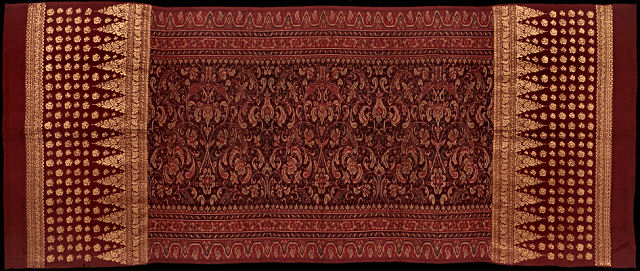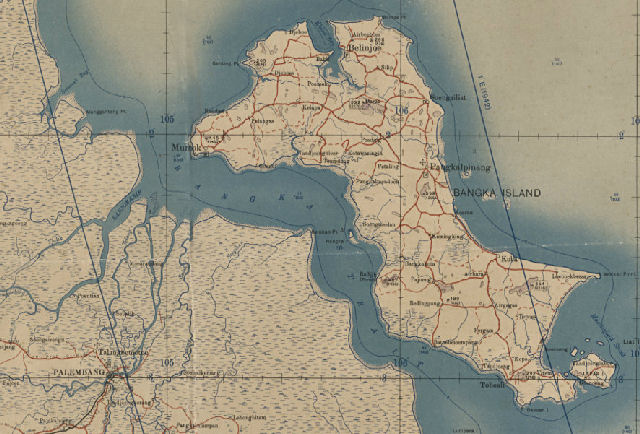 |

IKAT FROM BANGKA, INDONESIA
GALLERY 

- 069 BANGKA
Limar (shawl). Weft ikat. 18th to mid 19th c. Malay people. Probably Muntok village on Bangka, else from Palembang.
- 070 BANGKA
Limar (shawl). Weft ikat. 1750-1825. Bangka, probably Muntok village, Malay people.
- 147 BANGKA
Limar (shawl). Weft ikat. 1850-1900. Probably Muntuk on Bangka, less likely Palembang on Sumatra. Malay people.
Sumatra and Bangka - silk ikats with gold songket
One of the finest types of textiles in the world are the kain limar produced on Sumatra, Indonesia's second largest island after Kalimantan (Borneo), and on small neighbouring Bangka. Made of silk, decorated by means of weft ikat, and enriched with supplementary weft in gold thread, a method called songket, they have an immediate visual appeal. Kain limar are obvious treasures, and have always been passed on as heirlooms from generation to generation. Most old pieces suffer from missing filaments of gold on the folds, as a result of a century or more of folding and unfolding. Kain limar are so called, because the little dots that make up the designs (an effect of the ikat technique) bring to mind drops of squeezed lemon.
As a result of Islam's prohibition of the reproduction of living beings, the designs are always non-figurative, usually repeats of fine motifs in a tight grid, with patola inspiration often in evidence - or crypto-figurative, showing for instance motifs based on Garuda (the bird that serves as a mount to the Hindu god Vishnu), but so modified as to make recognition of the animal very hard even for the initiated. Like the majority of Indonesian ikat textiles, most kain limar have tumpal borders.
The origin of songket weaving on Sumatra and Bangka is disputed. Many authors assume that examples were introduced by traders from Mughal (i.e. Muslim dominated) India to the coastal Muslim sultanates in the Indonesian islands in the 15th or 16th C. Others maintain that the technique came from China, and much earlier: in the 7th to 12th century Srivijaya or Sri Vijaya Period, when southern Sumatra, with its capital at Srivijaya, modern day Palembang, was the centre of a powerful Buddhist state that covered much of Southeast Asia, and maintained very active trade links with China. Srivijaya served as a stopover for Chinese traders as well as Buddhist monks en route to India. The latter would often stay for several months or even longer to study Sanskrit, so that on arrival in India they would already be versed in the language of the scriptures.
There are other areas of Sumatra where textiles were decorated with gold thread, such as in the Minangkabau of western Sumatra, but silk ikats so decorated are a hallmark of the southeastern area around Palembang and of Bangka, the island just offshore.

Late 19th or early 20th C. kain limar in the Pusaka Collection, probably from Bangka. A true heirloom in silk ikat with gold brocade, used to display wealth.
Display of wealth and identity
These gold cloths were typically worn by women as part of ceremonial attire involving elaborate gold jewelry - matching the showiness of the men's krises with golden or jewel encrusted handles. These days, as Susan Rodgers observes in Gold Cloths of Sumatra: Indonesia's Songkets from Ceremony to Commodity, such display of wealth may be frowned upon in increasingly fundamentalist Islamic Sumatra: "Might showy songket attire detract or even contradict the subdued type of human personhood encouraged in some strains of modernist yet conservative Islam?" Still, the process of commodification of kain limar appears unstoppable, as ever wider segments of the population can afford them.
Apart from the growing middle class's desire to show its increasing economic power, what fires the sale of kain limar these days is also the desire to mark oneself as uniquely Sumatran, as opposed to Javanese, the dominant social group in Indonesia which, as a result of its sheer numbers (two thirds of the population), Java-centred political structure, and cultural dominance through the media, can sometimes be experienced as an oppressive foreign force, even on islands as large as Sumatra.
Predictably, as part of the commodification process, standards of precision have dropped, so that most modern cloths now lack the definition that made the older cloth so powerful. Gold thread, which used to consist of silk wrapped in pure gold leaf, is often replaced by cheap look-alikes. This downgrading is the inevitable result, seen around the world, of the crumbling of the feudal, hierarchical structures that allowed a narrow upper class to extort material and human resources from the wider population, which in its turn allowed the blossoming of material cultures of stunning refinement. It is hard to bemoan this loss, and hard not to.
Treasure, the lesser and the greater
No one will be surprised to learn that the fine silk ikats with gold songket made on Sumatra and Bangka are quite valuable. Anyone who first lays eyes on a kain limar will recognize it as a textile treasure. Even apart from the obviously demanding manufacture, its weight in gold alone makes it expensive. Interestingly though, kain limar do not command prices as high as those paid for a some of the much more basic cotton ikats from the Lesser Sunda Islands. An early 20th C. bridewealth cloth from Lembata for instance, made of coarse hand spun cotton, is worth about twice as much as a kain limar of the same age. The reason is the marked difference of spiritual value.
Kain limar served as the rulers' showpieces, their sole function beyond decoration being the display of wealth. Neither their manufacture nor their use was deeply steeped in tradition - except the taboo on their use outside the small circle of the higher ranking nobles. But this taboo did not survive the liberation of the country from the colonial oppressors. Once the Dutch were driven out, and the rulers lost their protection, both their thrones and privileges were up for grabs. Donning a kain limar became something any successful merchant's wife could aspire to. The bridewealth cloth of Lembata to the contrary were created in an atmosphere of tradition so rich in prescriptions and proscriptions, and so full of meaning, that women poured their soul into them for years - and it shows.
When you hold a handmade textile in your hands, the soul of the weaver is communicating with you. How it tells you, and how interesting the story is, is determined both by the physical circumstances of its manufacture, and by the state of mind of the maker. Was the cloth made on a frame loom in a workshop, for merely commercial reasons, to be sold via a broker? Or was it made on a back strap loom, to earn the woman the right to marry, or assure her a respected place in the island society? Was it a matter of producing x centimetres a day for y rupiahs? Or was it a matter of waiting for the right moon phase, the right maturity of a rare plant, the struggle with mordants to get an intense colouration? What was the worst that could happen to you: an unsatisfied foreman, or illness caused by angered spirits? The latter are the more more arresting, more compelling stories. Discerning collectors the world over willingly pay to more to hear these tense, thrilling stories, than the tales, however enchanting at first, of good living easily achieved.
Additional information on Bangka limar by John Ang
The island of Bangka was a prosperous tin mining region that once belonged to the Palembang Malay sultanate. It was run mostly by Chinese Muslims who were connected to the Palembang court through intermarriage. We know that Sultan Badaruddin I (1722-1757) married a Chinese wife. Most of these Chinese were Muslims from South China who had migrated to Siantan, in Anambas (northern Riau Islands situated between South Vietnam and North Borneo), before going to South Sumatra. The wealth of Bangka and Palembang made it possible to import expensive high-quality silk yarns from China for the weaving of these fine silk limar.
The characteristics of Banka limar, as opposed to those from its neighbour Palembang, are the use of yellow, green and blue natural dye colours together with purple and red. In Palembang, the limar were darker and more sombre as only reds and purples were used. For some reason the weaving industry died out in Bangka by 1920s and there are no more weavers on the island.
Another characteristic is the use of thin woven white lines on the tips of the triangular pucuk rebung or bamboo shoots that line the outer border of the end panels. Usually, the limar is executed in a combination of ikat and gold songket, brocade.
One aspect of Bangka limar textiles that few people highlight is their similarity to those from Riau-Lingga and to Cham weft ikat textiles. The reason for this similarity is that the Riau-Lingga court is known to have invited and employed Bangka weavers to their court to weave. In Riau-Lingga there is a village called Kampong Muntok, where weavers from Muntok settled. In Palembang and Bangka there is a record that many Chams went there for trade in textiles and tin mining and this connection may have possibly led to the similarities in their textiles. [Article informed by multiple sources including Barbara Andaya, 'The Cloth Trade of Jambi and Palembang During the 17th and 18th Centuries', and Philipp Bruckmayr, Cambodia’s Muslims and the Malay World.]
John Ang is an independent scholar specialised in Malay textiles
|
Literature
One of the better sources is Susan Rodgers, Anne Summerfield, John Summerfield, Gold Cloths of Sumatra: Indonesia's Songkets from Ceremony to Commodity.
Map of Bangka

Map showing Bangka and Palemband prepared by the Survey of India. Click on map to open high-resolution scan of area map made by Leyden University in seperate windown.
©Peter ten Hoopen, 2024. The contents of this website are provided for personal, educational, non-commercial use only.
No part of this website may be reproduced in any form without explicit permission of the copyright holder.
|  |



